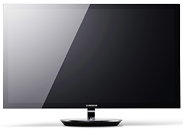Thursday, January 5th 2012

Samsung Preparing a 27-inch WQHD (2560 x 1440) Monitor
Next week at CES 2012, Samsung Electronics will show off for the first time its new Series 9 premium monitor, a slim and sexy widescreen called S27A970 which features a 27-inch PLS (Plane Line Switching) panel capable of a maximum resolution of 2560 x 1440 pixels.
Samsung's creation also has an anti-glare edge-to-edge glass display, an aluminum stand and base, a response time of 5 ms, 178/178 degree viewing angles, a static contrast ratio of 1,000:1, a maximum brightness of 300 cd/m2, two 7 W built-in speakers, a 2-port USB 2.0 hub, DVI, HDMI and DisplayPort inputs, plus a Mobile High Definition Link (MHL) enabling connectivity with MHL-supporting smartphones and tablets.
The Series 9 S27A970 is expected to become available in March priced at $1,200.
Samsung's creation also has an anti-glare edge-to-edge glass display, an aluminum stand and base, a response time of 5 ms, 178/178 degree viewing angles, a static contrast ratio of 1,000:1, a maximum brightness of 300 cd/m2, two 7 W built-in speakers, a 2-port USB 2.0 hub, DVI, HDMI and DisplayPort inputs, plus a Mobile High Definition Link (MHL) enabling connectivity with MHL-supporting smartphones and tablets.
The Series 9 S27A970 is expected to become available in March priced at $1,200.

69 Comments on Samsung Preparing a 27-inch WQHD (2560 x 1440) Monitor
Vice versa if the horizontal resolutions stay the same.
And all I want to know is, how is the color accuracy on these PLS panels? Are they true 8 bit? Do they look as good as a calibrated IPS?
You "only" gain more vertical pixels
16:9 = 2560 x 1440
16:10 = 2560 x 1600
4:3 = 2560 x 1920
Now, if the vertical resolutions were the same, 16:9 is obviously better
16:9 = 2560 x 1440
16:10 = 2304 x 1440
4:3 = 1920 x 1440
Its about how much you are paying, along with how much value you find in it. So if users who are going to buy this would rather have no cables showing, and rather have it wall mounted they should either have that option, or they won't buy it.
By your comment, everyone should just accept what they get, leading to no real innovation.
Seeing 16:10 still kicking around is very promising for future monitors though as I like the extra vertical space over 16:9, not to mention it looks better than a 16:9 screen physically.
en.wikipedia.org/wiki/16:10#16:10_-_properties
The 16:10 ratio, at 1.6, is close to the golden ratio (1.618, often denoted φ).
For movies? I don't use my monitor, TVs is what I use :)
So 16:9 is good on a TV, OK, but on a PC I'd rather pick 2560x1920 than 2560x1440.
:rolleyes:
So if you have 2560x1920 you actually use the additional resolution versus the 2560x1440 of a 16:9 screen.
Wider is better is only true for a monitor if it gives more resolution. A 16:10 or 4:3 monitor that has the same horizontal resolution is able to display everything a 16:9 monitor can, pixel perfect.
A theoretical 2560x1920 monitor will display absolutely everything that a 2560x1440 can, but the opposite is not true.
Therefore, the 4:3 monitor is the most versatile. It can still display all the 16:9 content for movies and TV, but it can do a hell of a lot more when you aren't watching movies or TV.
Heck where is the 21:9 TV Vizio promised?
2560x1440 is obviously better than 1920x1200. But then, 2560x1600 would be better still, strictly in terms of abilities.
And Phillips has 21:9 TVs if you are interested. And they are 2560x1080, so much better than the current crop of 1080p tvs. I wouldn't mind having one. www.philips.co.uk/c/cinema-21-9/30849/cat/#filterState0=CINEMA219_FLAT_TV_SE_GB_CONSUMER%3Dtrue
Lets use 1920 monitors 1080p (1920x1080) content to keep it simple and realistic.
16:9 = 1920x1080. Perfect fit.
16:10 = 1920x1200. Will display 100% the same image as the 1080p monitor at the same quality with a 60px black bar on top and bottom. Quality is 100% unchanged.
4:3 = 1920x1440. Will also display the 100% identical image, but with 180px bar on top and bottom. (Though none of these exist in the wild.)
If horizontal resolutions remain constant, the 16:10 and 4:3 are superior in abilities. They do absolutely everything a 16:9 monitor does with the exact same quality, and are capable of more when you aren't watching 16:9 content.
And if games are your argument, you can just set it to 16:9 if you want, as the 4:3/16:10 screen is capable of displaying an unaltered 16:9 image. Or, you can just tweak the FOV. Point remains though, that the 16:10 and 4:3 are capable of absolutely everything the 16:9 is. So my point still stands.